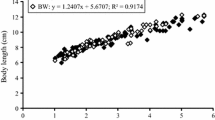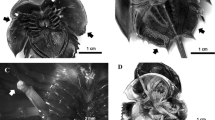Abstract
Prawns (Penaeus monodon) were obtained from ponds in Iloilo, Philippines, in 1984 and 1985 and maintained in salinities from 8 to 44‰. Total hemolymph calcium was largely affected by molt stage and less so by salinity. A sharp, transient increase in hemolymph calcium occurred 3 to 6 h postmolt, followed by an equally rapid decrease from 6 h postmolt to intermolt. This biphasis response was limited to prawns in 8, 20 and 32‰S; in 44‰S, hemolymph calcium remained the same throughout the sampling period. Peak concentrations of total calcium were greater in low (8 and 20‰S) than in high salinities. Salinity had no effect on the duration of molt cycle nor on time of occurrence of molt. Almost half of molting incidents occurred between 18.01 and 0.00 hrs, and one-third between 0.01 and 06.00 hrs.
Similar content being viewed by others
Literature cited
Apud, F., Primavera, J., Torres, P. (1983). Farming of prawns and shrimps. Southeast Asian Fisheries Development Center, Iloilo, Philippines (Extension Manual No. 5)
Bittner, G. D., Kopanda, R. (1973). Factors influencing molting in the crayfish Procambarus clarkii. J. exp. Zool. 186: 7–16
Central Inland Fisheries Research Institute (CIFRI) (1977). Revised notes on the methodology for culture of Penaeus monodon. CIFRI, Barrackpore, India, p. 1–17. (Contrib. No. 10)
Charmantier, G., Thuet, P., Charmantier-Daures, M. (1984). La regulation osmotique et ionique chez Homarus gammarus (L.) (Crustacea: Decapoda). J. exp. mar. Biol. Ecol. 76: 191–199
Dall, W. (1965). Studies on the physiology of a shrimp: Metapenaeus sp. V. Calcium metabolism. Aust. J. mar. Freshwat. Res. 16: 181–203
Ferraris, R. P., Parado-Estepa, F. D., de Jesus, E. G., Ladja, J. M. (1987). Osmotic and chloride regulation in the hemolymph of the tiger prawn Penaeus monodon during molting in various salinities. Mar. Biol. 95: 377–386
Ferraris, R. P., Parado-Estepa, F. D., Ladja, J. M., de Jesus, E. G. (1986). Effect of salinity on the osmotic, chloride, total protein and calcium concentrations in the hemolymph of the prawn Penaeus monodon (Fabricius). Comp. Biochem. Physiol. 83A: 701–708
Fieber, L. A., Lutz, P. L. (1985). Magnesium and calcium metabolism during molting in the freshwater prawn Macrobrachium rosenbergii. Can. J. Zool. 63: 1120–1124
Graf, F. (1978). Les sources de calcium pour les crustaces venant de muer. Archs Zool. exp. gén. 119: 143–161
Greenaway, P. (1974). Calcium balance at the premolt stage of the freshwater crayfish Austropotamobius pallipes (Lereboullet). J. exp. Biol. 61: 27–43
Greenaway, P. (1983). Uptake of calcium at the postmolt stage by the marine crabs Callinectes sapidus and Carcinus maenas. Comp. Biochem. Physiol. 75A: 181–184
Haefner, P. A. (1964). Hemolymph calcium fluctuations as related to environmental salinity during ecdysis of the blue crab, Callinectes sapidus Rathbun. Physiol. Zoöl. 37: 247–258
Hagerman, L. (1973). Ionic regulation in relation to the moult cycle of Crangon vulgaris (Fabr.) (Crustacea, Natantia) from brackishwater. Ophelia 12: 141–149
Hartley, H. O. (1961). The modified Gauss-Newton method for the fitting of non-linear regression functions by least squares. Technometrics 3: 269–280
Hartnoll, R. G. (1978). The effect of salinity and temperature on the postlarval growth of the crab Rithropanopeus harrissii. In: McClusky, D. S., Berry, A. J. (eds.) Physiology and behaviour of marine organisms. Pergamon Press. Oxford, p. 349–358
Henry, R. O., Kormanik, G. A. (1985). Carbonic anhydrase activity and calcium deposition during the molt cycle of the blue crab Callinectes sapidus. J. Crustacean Biol. 5: 234–241
Huner, J. V., Colvin, L. B., Reid, B. L. (1979). Whole-body calcium, magnesium and phosphorus levels of the california brown shrimp, Penaeus californiensis (Decapoda: Penaeidae) as functions of molt stage. Comp. Biochem. Physiol. 64A: 33–36
Ling, S. W., Merican, A. B. O. (1961). Notes on the life cycle and habits of the adult and larval stages of Macrobrachium rosenbergii (De Man). Proc. Indo-Pacific. Fish. Coun. 9: 55–61
Mantel, L., Farmer, L. (1983). Osmotic and ionic regulation. In: Bliss, D. E. (ed.) The biology of Crustacea. Vol. 5. Academic Press, New York, p. 53–161
McFarland, W., Lee, B. (1963). Osmotic and ionic concentrations of penaeidean shrimps of the Texas coast. Bull. mar. Sci. Gulf Caribb. 13: 391–417
Parado-Estepa, F. D., Ferraris, R. P., Ladja, J. M., de Jesus, E. G. (1987). Responses of intermolt Penaeus indicus to large fluctuations in environmental salinity. Aquaculture, Amsterdam 64: 175–184
Price-Sheets, W. C., Dendinger, J. E. (1983). Calcium deposition into the cuticle of the blue crab, Callinectes sapidus related to external salinity. Comp. Biochem. Physiol. 74A: 903–907
Robertson, J. D. (1960). Osmotic and ionic regulation. In: Waterman, T. H. (ed.) Crustacean physiology. Academic Press, New York, p. 317–339
Tagatz, M. E. (1968). Growth of the juvenile blue crabs, Callinectes sapidus Rathbun in the St. John River, Florida. Fish. Bull. U.S. 67: 281–288
Travis, D. F. (1955). The molting cycle of the spiny lobster, Panulirus argus Latreille. III. Physiological changes which occur in the blood and urine during the normal molting cycle. Biol. Bull. mar. biol. Lab., Woods Hole 109: 484–503
Vernet-Cornubert, G. (1964). Comparaison entre les effets provoqués par l'epedonculation et par la regeneration intensive sur la mue et la croissance chez Pachygrapsus marmoratus (Fabricius). Bull. Inst. océanogr. Monaco 61: 1–20
Wright, D. A. (1979). Calcium regulation in intermolt Gammarus plexus. J. exp. Biol. 83: 131–144
Author information
Authors and Affiliations
Additional information
Communicated by J.M. Lawrence, Tampa
Rights and permissions
About this article
Cite this article
Parado-Estepa, F.D., Ladja, J.M., de Jesus, E.G. et al. Effect of salinity on hemolymph calcium concentration during the molt cycle of the prawn Penaeus monodon . Mar. Biol. 102, 189–193 (1989). https://doi.org/10.1007/BF00428279
Accepted:
Issue Date:
DOI: https://doi.org/10.1007/BF00428279




